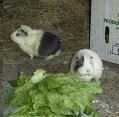|
 Home Home
 What's New? What's New?
 Definition Definition
 Our Design Our Design
 Techniques Techniques
 Articles Articles
 Blog Blog
 About Us About Us
 Year Planner Year Planner
 Resources Resources
 Links Links

Like us on
FaceBook!

Link to this site
|
|
Permaculture Techniques - Integrating Animals into a Permaculture Design
Benefits of Integrating Animals
Factors to Consider
List of Useful Animals
Animals (including micro-organisms, insects, reptiles, amphibians, birds, animals, fish, crustaceans, spiders, etc) are essential in a complete ecosystem and serve a variety of purposes related to the health and vitality of the system.
Careful thought and planning needs to go into the selection and integration of animals into the eco-system. It's best to wait until the permaculture design is at the stage where it can sustain them. Animals are placed in a permaculture system in such a way that natural succession is ensured, are able to self-forage and provide some of the labour required to maintain system. They can be used to clear up excess food or plant growth, produce fertiliser and food for other animals and human consumption, or provide other useful products, such as wool, skins, feathers, or horn. Animals can also act as indicators of impending disaster and some are effective guard animals.
Animals are great for children, providing a valuable educational function, as well as the opportunity to develop values of respect and consideration for the many other creatures that share the planet with us.
Animals need to be chosen according to the scale, location, & requirements of the particular system. We preferred small animals which can be easily maintained for our 4.5 acre site. Other permaculture designs may include animals as varied as horses, alpacas, marron, barramundi, crocodiles, emus or worms! One thing is certain though - you'll always find a huge range of animals in any permaculture system.
The Benefits
The benefits of integrating animals into a permaculture design are many:
- Produce manure, may concentrate essential minerals and nutrients in food chain.
- Foragers of fallen fruit, surplus plant materials.
- Act as pollinators.
- Can be used as heat sources in enclosed systems such as barns, greenhouses.
- Can be carbon dioxide producers in greenhouses, glasshouses.
- Act as soil conditioners, soil borne aerators and soil "ploughers".
- Useful for weeding and weed control.
- Supply labour, replacing machinery, vehicles or human effort.
- Pest control.
- Cleansing filters for water (eg mussels)
- Grazers, especially for fire and weed control.
- Producers of fibre products (wool, fur, hair, feathers).
- Protein source (meat, eggs, game, milk).
- Companions for people.
- Source of sugar, especially honey.
- Providers of security (watchdogs, geese).
- Can be used for transport (ponies, donkeys, horses, in some areas camels!)
- Seed distributors, and in some cases, pre-treatment of seeds.
- Regulation of animal (or pest) populations; predators.

Factors
There are many factors to consider when integrating animals into a permaculture design:
- Study the needs and characteristics of existing fauna and wildlife on site (they may present information pertinent to the design; eg animal paths, indicators of site factors/soil condition, etc).
- Research the needs and characteristics of each animal species and group to be considered.
- Determine the animal associations and interactions, both animal/animal, animal/plant and animal/inorganic elements (structures - existing and planned).
- List all known functions and yields for each animal species, or group.
- Planning plantings and structures according to the information collected as above, considering: water, shelter, climate, microclimate, social behaviour, preferred group size, food, mineral requirements, extreme weather conditions and other potential hazards, population densities.
- Plan associations so that each element (plant/animal/structure interaction) serves the needs and is able to use the products of other elements.
- Introduce animal species to suit evolving design, starting small and manageable, building up stocks as the system evolves.
- Provide (regenerate) native plant corridors, or conserve and protect habitats of native animals.
|
|

Our ever-changing view!
Moonset ~ Roll Cloud ~ Sunset
|
permaculture ethics |
care for earth,
care for people,
return surplus,
reduce consumption |
 |
|
Recently Added Pages
Hot Links!

Bookworm is currently reading...
This site is sponsored by
ALWAYS LEARNING BOOKS
Publishers of Australian
books on Home Education.
  The Educating Parent The Educating Parent
  Beverley's other websites Beverley's other websites
|





